Menus
- Before spring
- Subordinate importance of the maximum performance
- Engine and consumption
- Torque curves
- Sitting position
- Undercarriages
- Braking power is guaranteed to be sufficient
- Equipment luxury
- Traction control
- Placements
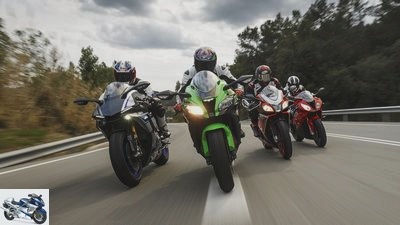
Jorg Kunstle
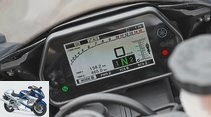
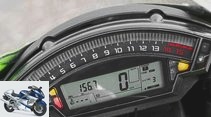
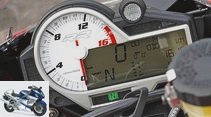
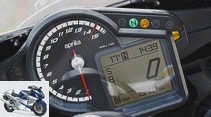
36 photos
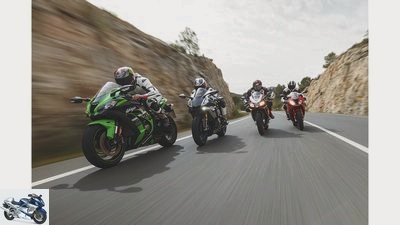
1/36
Comparison test of superbikes: Aprilia RSV4 RF, BMW S 1000 RR, Kawasaki ZX-10R, Yamaha YZF-R1M.
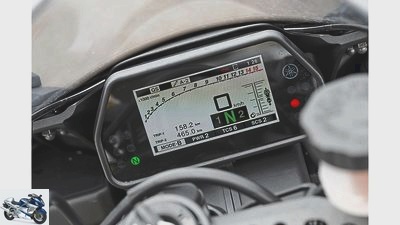
2/36
Information Yamaha:
If you don’t just get the shift speed signaled, but simply want to read the speed from time to time, the analog displays from Aprilia and BMW are best served. The information offered here is configured for everyday use, but the Aprilia, BMW and Yamaha instruments can also be adapted to the needs of racing drivers. With fewer but larger displays and stopwatch functions.
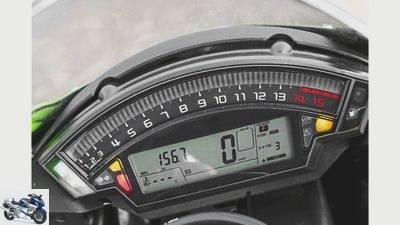
3/36
Information Kawasaki:
If you don’t just get the shift speed signaled, but simply want to read the speed from time to time, the analog displays from Aprilia and BMW are best served. The information offered here is configured for everyday use, but the Aprilia, BMW and Yamaha instruments can also be adapted to the needs of racing drivers. With fewer but larger displays and stopwatch functions.
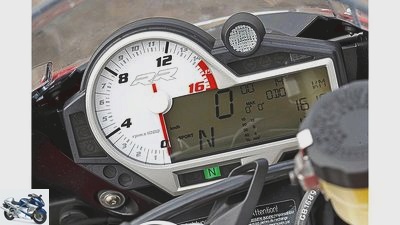
4/36
Information BMW:
If you don’t just get the shift speed signaled, but simply want to read the speed from time to time, the analog displays from Aprilia and BMW are best served. The information offered here is configured for everyday use, but the Aprilia, BMW and Yamaha instruments can also be adapted to the needs of racing drivers. With fewer but larger displays and stopwatch functions.
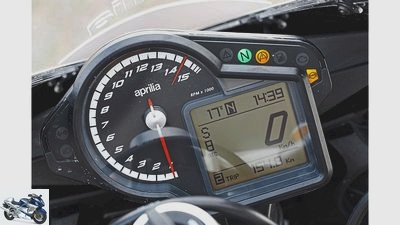
5/36
Information Aprilia:
If you don’t just get the shift speed signaled, but simply want to read the speed from time to time, the analog displays from Aprilia and BMW are best served. The information offered here is configured for everyday use, but the Aprilia, BMW and Yamaha instruments can also be adapted to the needs of racing drivers. With fewer but larger displays and stopwatch functions.
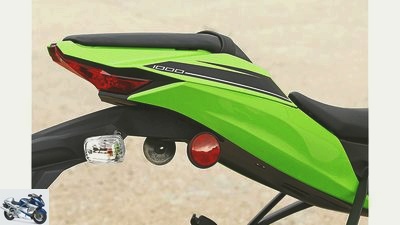
6/36
The Kawasaki is the only one to have passed the Euro 4 hurdle. Euro 4 motorcycles are easy to recognize by their side reflectors, which do not always look good.
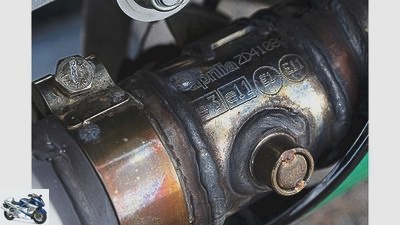
7/36
Euro 3 and 4 – a not entirely fair comparison.
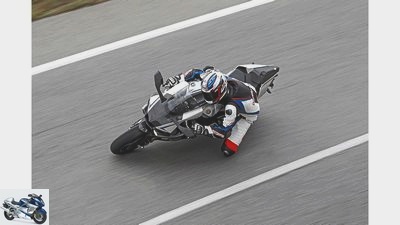
8/36
The M version of the YZF-R1 is refined with carbon parts and an electronic chassis and is extremely sporty.
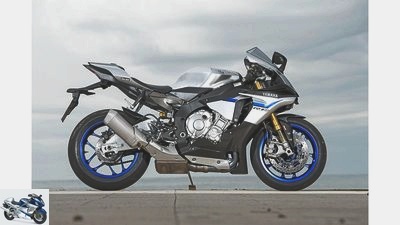
9/36
Yamaha YZF-R1M.
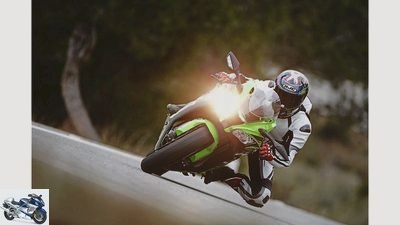
10/36
The new Kawa is not the handiest, but it gives you absolute confidence in the front end. Your standard tires are great.
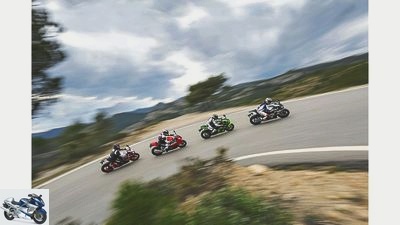
11/36
This curve looks like it has been drawn far. In fact, it’s so tight that athletes need first gear. And get through without clutch loops.
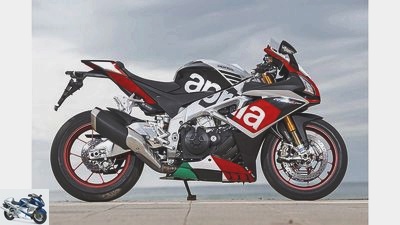
12/36
Aprilia RSV4 RF.
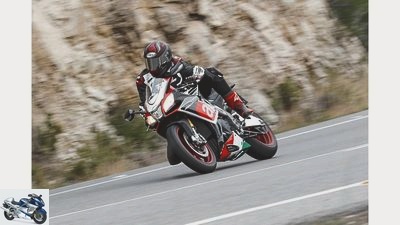
13/36
They’re all handy, somehow. But the Aprilia combines this virtue with the highest steering precision and stability.
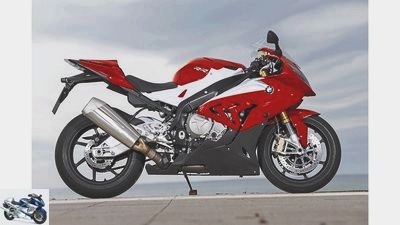
14/36
BMW S 1000 RR.
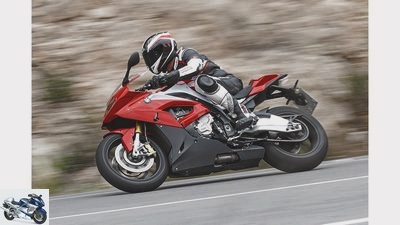
15/36
The BMW engine carries two souls in its block. Serene and vigorous in the middle range, above 10,000 rpm a tearing animal.
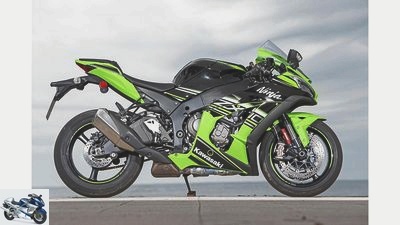
16/36
Kawasaki ZX-10R.
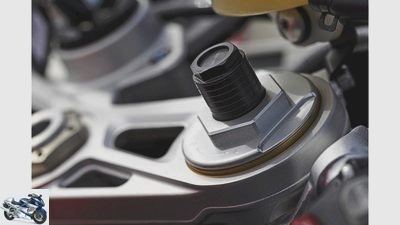
17/36
Setting BMW:
The rebound adjuster sits in the blue anodized preload screw of the Aprilia fork. As with the Kawasaki, you have to count the revolutions when adjusting the preload. The asymmetrically constructed Sachs fork of the BMW, however, always shows the value. The preload on the R1 Ohlins fork can only be changed after the plug has been removed.
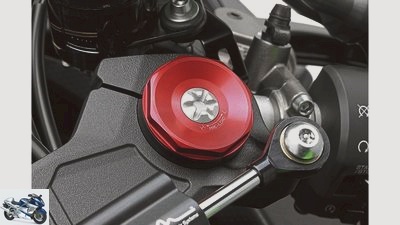
Kawasaki
18/36
Attitude Kawasaki:
The rebound adjuster sits in the blue anodized preload screw of the Aprilia fork. As with the Kawasaki, you have to count the revolutions when adjusting the preload. The asymmetrically constructed Sachs fork of the BMW, however, always shows the value. The preload on the R1 Ohlins fork can only be changed after the plug has been removed.
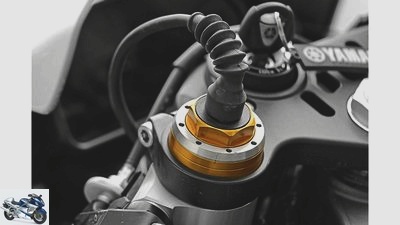
19/36
Setting Yamaha:
The rebound adjuster sits in the blue anodized preload screw of the Aprilia fork. As with the Kawasaki, you have to count the revolutions when adjusting the preload. The asymmetrically constructed Sachs fork of the BMW, however, always shows the value. The preload on the R1 Ohlins fork can only be changed after the plug has been removed.
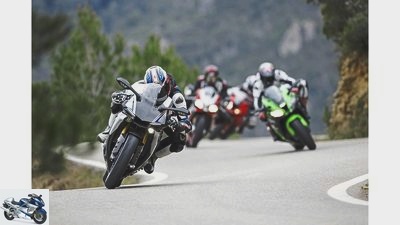
20/36
Swinging Sixties: On this narrow, winding strip of asphalt, you rarely travel at more than 60 km / h.
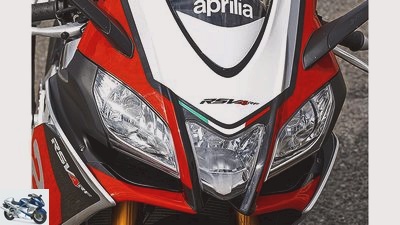
21/36
Design Aprilia:
Those were the days when Ram-Air was a unique selling point. The power output of modern engines would not be possible without pressure ventilation with cubic meters of cool air. The inlets required for this largely determine the appearance of the front section.
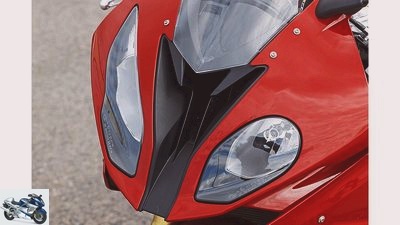
22/36
Design BMW:
Those were the days when Ram-Air was a unique selling point. The power output of modern engines would not be possible without pressure ventilation with cubic meters of cool air. The inlets required for this largely determine the appearance of the front section.
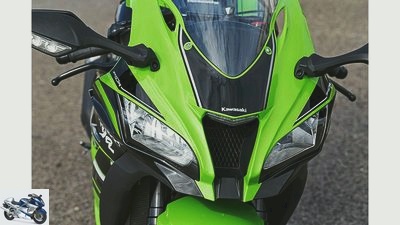
23/36
Design Kawasaki:
Those were the days when Ram-Air was a unique selling point. The power output of modern engines would not be possible without pressure ventilation with cubic meters of cool air. The inlets required for this largely determine the appearance of the front section.
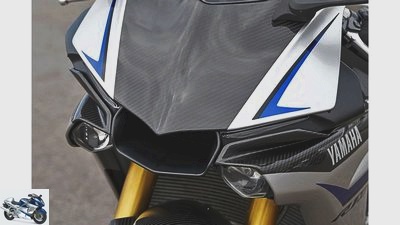
24/36
Design Yamaha:
Those were the days when Ram-Air was a unique selling point. The power output of modern engines would not be possible without pressure ventilation with cubic meters of cool air. The inlets required for this largely determine the appearance of the front section. The Yamaha appeals with an innovative combination of LED light strips and projection headlights.
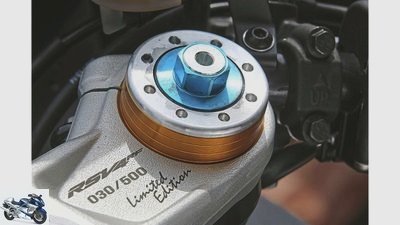
markus-jahn.com
25/36
Setting Aprilia:
The rebound adjuster sits in the blue anodized preload screw of the Aprilia fork. As with the Kawasaki, you have to count the revolutions when adjusting the preload. The asymmetrically constructed Sachs fork of the BMW, however, always shows the value. The preload on the R1 Ohlins fork can only be changed after the plug has been removed.
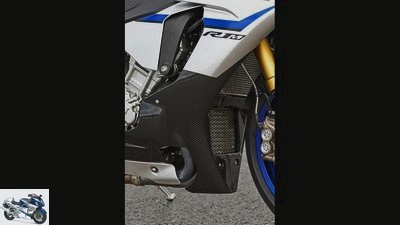
26/36
The YZF-R1 and the S 1000 RR have a classic, air-flow oil cooler.
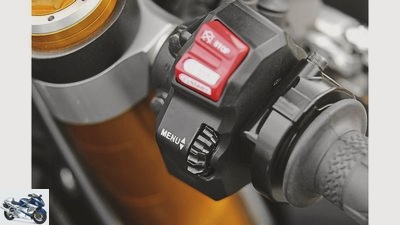
27/36
Operation Yamaha:
There is a lot to turn and press if you want to use the various electronic driving aids. The route through the menus is not easy to find on every motorcycle, but the separation of functions that you can adjust while driving and those that you have to stop to adjust is always sensible. For example, when setting the driving modes.

28/36
Sound Aprilia:
The Aprilia and the BMW have the strongest voices. The BMW even lets out a threatening babble when overrun and injects tiny amounts of petrol into the combustion chambers.
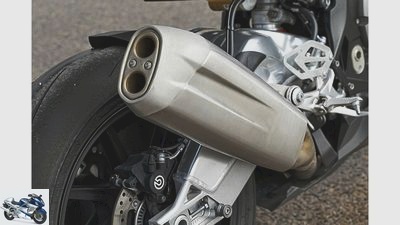
29/36
Sound BMW:
The Aprilia and the BMW have the strongest voices. The BMW even lets out a threatening babble when overrun and injects tiny amounts of petrol into the combustion chambers.
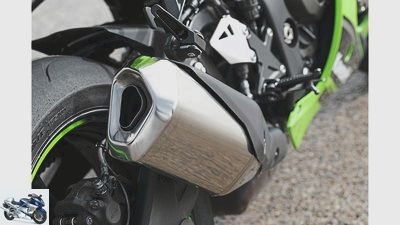
30/36
Sound Kawasaki:
The Kawasaki and Yamaha express themselves cautiously in Japanese. It should also be noted that the exhaust system of the Kawasaki is made of titanium.
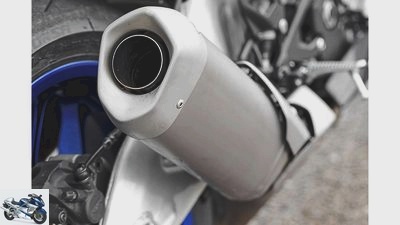
31/36
Sound Yamaha:
The Kawasaki and Yamaha express themselves cautiously in Japanese.
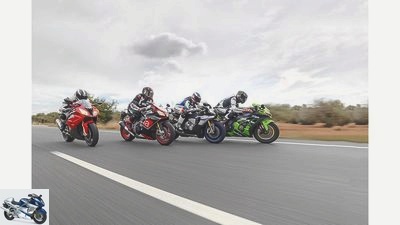
32/36
When trying to determine the pulling power according to the farmer’s method, the three in front produced an early start. In fact, the order is reversed.
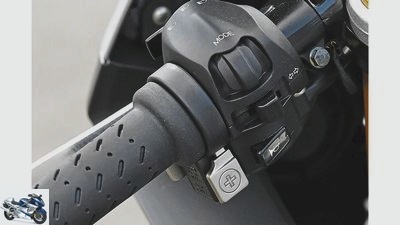
33/36
Operation Aprilia:
There is a lot to turn and press if you want to use the various electronic driving aids. The route through the menus is not easy to find on every motorcycle, but the separation of functions that you can adjust while driving and those that you have to stop to adjust is always sensible. For example, when setting the driving modes.
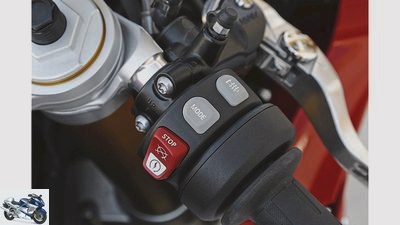
BMW
34/36
Operation BMW:
There is a lot to turn and press if you want to use the various electronic driving aids. The route through the menus is not easy to find on every motorcycle, but the separation of functions that you can adjust while driving and those that you have to stop to adjust is always sensible. For example, when setting the driving modes.
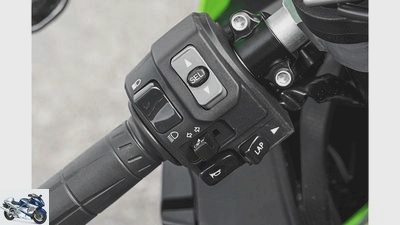
35/36
Operation Kawasaki:
There is a lot to turn and press if you want to use the various electronic driving aids. The route through the menus is not easy to find on every motorcycle, but the separation of functions that you can adjust while driving and those that you have to stop to adjust is always sensible. For example, when setting the driving modes.
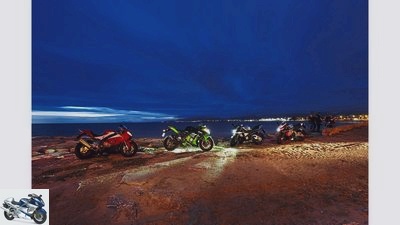
36/36
Comparison test of superbikes: Aprilia RSV4 RF, BMW S 1000 RR, Kawasaki ZX-10R, Yamaha YZF-R1M.
Comparison test of superbikes, part 1: Country road
Before spring
Aprilia RSV4 RF, BMW S 1000 RR, Kawasaki ZX-10R and Yamaha YZF-R1M have to show what they can do in the athlete test in Spain – in the first part on the country road, in the second on the racetrack.
The weather, once again. Even during the first days, which were still somewhat sunny, a cold, sharp wind blew through the hinterland of the Spanish coastal town of Cambrils; the streets were damp in places and often salty. The later consumption drive led at its highest point and at the height of the bad weather front through ankle-deep snow, and Aprilia RSV4 RF, BMW S 1000 RR, Kthe awasaki ZX-10R and Yamaha YZF-R1M were constantly cleaned and washed because the lower parts of them always looked as if they were about to be cooked in salt. Then a strong, gusty wind came up again.
Buy complete article
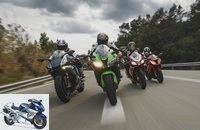
Comparison test of superbikes, part 1: Country road
Before spring
RSV4 RF from 2015, the BMW S 1000 RR with dynamic and race package as special equipment and the limited number of available Yamaha YZF-R1M with semi-active chassis. For Aprilia, it has to be added that the 2016 edition of the RF is not limited and differs from the test motorcycle by a minimally changed basic setup of the shock absorber and some details of the paintwork. The R1M is offered again in a limited edition year after year; it can only be ordered online. At the time this issue went to press, the allotment for 2016 was already sold out.
Subordinate importance of the maximum performance
Three four-cylinder in-line engines, two with conventional firing order (BMW S 1000 RR and Kawasaki ZX-10R) and one that ignites like a 90-degree V4 (Yamaha YZF-R1M), meet the real 65-degree V4 of the Aprilia RSV4 RF. The test candidates had to be put to the test before the winter escape to the south. This made it clear that even the extensively revised engine of the Kawasaki would not be able to displace the Bavarian top dog from its leadership position. Despite this knowledge, it is astonishing how irresistibly the BMW S 1000 RR distances its competitors. And in terms of suitability for everyday use, that has nothing to do with the top performance of the Bavarian four-cylinder. At the high level on which all four motorcycles move, maximum power is of secondary importance anyway. Not only in everyday traffic, but also on the racetrack. What happens when one of the four is in the run for maximum performance can hardly be described anyway. Anyone who has already savored this to the full can feel like a member of a relatively small group, measured by the total number of motorcyclists.
Rather, it is the pronounced torque overhang in the lower and medium engine speed range that suits the BMW driver in everyday traffic, when driving errors and under difficult conditions. This is accompanied by an almost perfect response behavior and smooth load changes, especially in Sport mode. That makes it easy, sensitive and well-dosed to deal with the abundant pulling power of the BMW S 1000 RR.
Engine and consumption
Anyone who has followed the development of the Aprilia V4 in recent years will not be surprised to see it in second place in the engine ranking. Far from the BMW S 1000 RR, but clearly differentiated from the Kawasaki ZX-10R and the Yamaha YZF-R1M. This is not only in the table of points, it is also noticeable. The compact V-engine from Italy impresses with its spontaneous willingness to perform, an almost perfectly linear power delivery and, in the Sport mode, its pleasing response behavior. Driving errors such as too high a gear in a surprisingly tight bend can be easily repaired, often without shifting down. Mechanical running smoothness is not the strength of the Aprilia power plant – not even that of the BMW engine – and the running noises are pithy. 5.8 liters of fuel consumption per 100 kilometers of cautious driving are also no cause for enthusiasm. However, they remain within tolerable limits and are a further indication of the progress made by the engine concept compared to the first series petrol drinkers.
The Kawasaki ZX-10R with 5.5 liters per 100 kilometers had the lowest consumption, followed by the BMW S 1000 RR with 5.7 liters, the Aprilia RSV4 RF and finally the Yamaha YZF-R1M, which got exactly six in the comparison drive Liter swallowed. The range with one filling of the pretty 17-liter aluminum tank is therefore a maximum of 283 kilometers. In fact, the R1 always had to be the first to reach the pump.
Torque curves
In contrast to the two European machines, the Aprilia RSV4 RF and BMW S 1000 RR, the torque curves of the Kawasaki ZX-10R and Yamaha YZF-R1M can be quite sluggish up to around 7000 rpm. Anyone who gets into a situation at low revs in which they need a strong boost for a short time is often not adequately served. The relatively long translations of the lower gears also play a role. The long first gear of the is a frequently used driving gear on winding country roads, and by no means just a starting gear. Kawasaki takes this interpretation to the extreme, which is advantageous on the racetrack because of the tight gradation of the following gears. The response of the two Japanese four-cylinder engines is also not entirely convincing in comparison, albeit for different reasons. The Kawasaki accelerates with a slight delay, the Yamaha quite hard, even in Power 2 mode, which is supposed to bring a smoother response at full power.
However, the smooth running of the two up to the highest speeds is exemplary. Even the Yamaha YZF-R1M, which with its crossplane crankshaft does not have the advantage of consistently long ignition intervals, thanks to its balancer shaft, produces more gentle pulsing than real vibrations over the entire speed range. Very pleasant and nice to listen to, especially at high speeds.
Sitting position
The ergonomics combine everyday and racing suitability far less than the engine characteristics. A relatively upright position for supersport conditions with higher handlebar halves and lower seat provides a good overview of the route and traffic, and is more comfortable. The BMW S 1000 RR and the Kawasaki ZX-10R cultivate this approach, with BMW going a little further. The deep seat makes the knee angle quite tight for riders with longer legs. In some situations you would also like to sit higher because it makes it easier to come forward. Unfortunately there is no higher seat cushion available as an optional accessory. It is hereby suggested.
For driving on the racetrack, a more front-wheel-oriented seating position is required, in which the driver sits over rather than in the motorcycle. In this way he gains more freedom of movement in the longitudinal direction and can use his body weight more efficiently depending on the driving situation. Especially in the acceleration phases when a lot of front wheel load is required. Their importance for fast laps has increased significantly due to the enormous grip of 200 mm rear tires and the immense power of current engines compared to better braking stability. The seating position on the Aprilia RSV4 RF and the Yamaha YZF-R1M is designed with this in mind.
What was considered extreme just a few years ago by the super athletes has now taken these two to the extreme. This is particularly strenuous when driving on the country road and tempts you to relieve yourself more often by accelerating strongly. If only the first gear didn’t reach over 150 km / h. Relaxed rolling in rush hour traffic – not thinking about it. And the great minutes – great moments will probably not turn out to be -, in which the Aprilia RSV4 RF and Yamaha YZF-R1M can develop their highly successful combination of agility and precision, are rare and precious off the racetrack. It’s best to get used to getting up early on Sundays. BMW S 1000 RR and Kawasaki ZX-10R allow you to endure adverse traffic conditions with a little more patience. However, one should not overestimate the differences just described. They are noticeable in direct comparison, certainly, but not nearly as big as between a super sports car and a sporty naked bike. Mostly it’s about tendencies, often just nuances. All four are racing motorcycles in disguise, none of them are out of line.
Undercarriages
This also makes it clear that the suspension elements cannot offer the litter-like comfort of a travel enduro with long suspension travel. For this, the damping characteristics are set too far on the tight side of the scale with regard to the racetrack. But it is always a pleasant surprise how well the high mechanical quality and the complex hydraulics of top-class sporty chassis components also work on mundane public roads.
As already mentioned, the BMW S 1000 RR and the Yamaha YZF-R1M are equipped with electronically controlled, semi-active suspension elements, the Aprilia RSV4 RF with the conventional variant of the Ohlins chassis that is in the Yamaha, and the new Kawasaki has the No less fine Showa components of the latest generation have been added. They all undermined the industriousness of the testers by simply working brilliantly on the default setting. “Shouldn’t we try something different?” “No, why?” “Just so that we are not satisfied with the first one.” “Okay.”
After all, the test team found that the Showa fork of the Kawasaki ZX-10R with less damping offers more comfort on bumpy bumps, but the motorcycle does not necessarily drive better overall. It is important to precisely synchronize the front and rear suspension, otherwise the ZX-10R will nod a tad too much around its center of gravity. The synchronization is not done with simply unscrewing the adjusting screws at the front and rear by the same amount. If you open the rebound stage on the fork three turns and the compression stage four revolutions, you can also open three revolutions at the rear and thus in proportion further than the front. A suitable base for the country road.
The Ohlins elements of the Aprilia RSV4 RF remained wide open, as recommended in the manual for road use. In detail: On the fork the rebound stage was 14, the compression stage twelve clicks open, the rear rebound stage 18, the compression stage 15 clicks. Fits. On the BMW S 1000 RR, the semi-active damping system in the factory setting of the Sport mode satisfied everyone, the same applies to the semi-active Ohlins system of the Yamaha YZF-R1M in the A2 automatic mode.
Braking power is guaranteed to be sufficient
Much less spectacular on the outside than the engine data, but the brakes are just as powerful. Even for brisk country road operations, the energy converters are quite underutilized. Four-piston fixed calipers and disc diameters of 320 and, in the case of the Kawasaki ZX-10R, even 330 millimeters guarantee sufficient braking power at all times. Differences in the stamina of the individual systems only came to light during the racetrack tests. The rest, namely the question of whether a brake bites quickly or poisonously, is a question of coordination. Since the introduction of anti-lock braking systems, there has been a tendency towards increasingly snappy friction pairings. Simply because the risk of a fall due to a blocked front wheel is eliminated thanks to the electronics.
The differences in response behavior are also getting smaller and smaller. In this narrow framework, the BMW brakes were the sharpest, followed by the Yamaha, Kawasaki and Aprilia. In the case of the Kawasaki, it seems reasonable to assume that the brake response is not only controlled by the friction pairing, but also by the electronics. When the ZX-10R was presented on the Sepang race track, the same system responded much more acutely. At that time the ABS was deactivated by a special plug because it did not harmonize with the slicks and would have intervened too early. With the other motorcycles, there is no evidence of an electronically influenced build-up of brake pressure when the ABS is switched off. This is easily possible with the Aprilia RSV4 RF and BMW S 1000 RR, while the Japanese manufacturers only allow this in exceptional cases – see Kawasaki. Yamaha does not even announce whether and how this would be possible with the R1.
The BMW S 1000 RR and Yamaha YZF-R1M are equipped with partially integrated brake systems that activate the rear brake even if the driver only pulls the hand lever. This means that a short impulse from the rear wheel brake can be set at the beginning of every braking process, which benefits the braking stability.
Equipment luxury
So it would be time to pay tribute to the sometimes lavish equipment luxury with which each of the four motorcycles pampers the rider in its own way. The first honorable mention is due – who would have thought it? – the heated grips of the BMW S 1000 RR. And please don’t let anyone think that they only benefit everyday suitability. A number of long-distance racers have come to appreciate this fine extra. It looks similar with the Shift Assistant Pro, which enables upshifts and downshifts without the clutch. The BMW can be driven lazily, but if you have to quickly step down two gears in the loop, you are happy to accept the offer.
The shift assistant of the BMW also works smoothly when, as is typical for country roads, upshifts at partial load without the clutch. If it works. Because during the country road test drives, the assistant took more and more time off; at the racetrack test, he finally went on strike. Presumably a creeping defect paralyzed the pressure and tension sensor on the shift rod.
The other manufacturers are still suspicious of such a blipper function of the shift assistant. They are probably worried about the durability of their gearboxes. After all, Kawasaki offers this function in connection with the control unit of the racing kit. With the Yamaha YZF-R1M, two different ignition interruption times can be selected for upshifting. The difference between them, however, is so subtle that you couldn’t feel it while driving.
Traction control
The traction control functions offered by the four super athletes were hardly noticeable despite the sometimes unfavorable road conditions. And that is to be understood as great praise. The electronics work so quickly, control so finely and allow so much up to the control range that they do not prevent anyone from developing their driving skills. And nevertheless intervenes discreetly if it is no longer sufficient to defuse a dangerous situation in exuberance. For example, you can safely set the drift control of the Yamaha YZF-R1M to the most defensive level. Few stunt drivers can imagine what you have to do to even need them. The noble mechanical components, on the other hand, offer an always obvious pleasure. Whether it is the finely crafted frame and swing arm, the spring elements or the wonderfully light wheels, the sight of them is comforting even after a delayed beginning of spring.
Placements
1. BMW S 1000 RR
This is not surprising: thanks to a powerful engine and a chassis concept suitable for everyday use plus moderate ergonomics, the BMW clearly wins this comparison. It is also best suited to different needs.
2. Yamaha YZF-R1M
Above all, it is the chassis qualities – even better than the standard model thanks to the semi-active damping – that secure the Yamaha second place. With a little better pulling power, even more would be possible.
3. Aprilia RSV4 RF
Great engine, great driving characteristics, extreme design. And in favor of faster lap times. That cannot bring a top position in a country road ranking. Especially since the Aprilia’s noble equipment has to be paid for dearly.
4. Kawasaki ZX-10R
Although the Kawasaki developers primarily wanted to promote the racing suitability of their ZX-10R, it shows high quality in everyday life. Like its predecessor, however, it suffers from its low-torque engine.
Scoring and measurement results can be seen in the complete test as a PDF download above in the article.
Related articles
-
Comparison test of superbikes part 2 – racetrack
51 pictures 1/51 The Kawa brake was transformed. She looked dull and lacked exact feedback. …
-
Superbikes 2012 – The super athletes on the country road
30th photos 1/30 The super athletes: Aprilia RSV4 Factory APRC, BMW S 1000 RR, Ducati 1199 Panigale S, Honda Fireblade,…
-
PS Bridgestone Tuner GP 2016 – 1000 Superbikes in comparison test
fact 27 photos markus-jahn.com 1/27 Picture gallery, TunerGP: 1000 Superbikes in comparison. markus-jahn.com 2/27 Bartschat-Kawasaki ZX-10R. Lap time:…
-
Comparison test of the 1000 super sports car, part 1
Jahn Comparison test of the 1000 super sports car, part 1 The full program Lean, strong, ready for attack, the Suzuki GSX-R 1000 completes the field of…
-
2017 super sports car in the country road comparison test
fact 28 photos factstudio.de 1/28 The 2017 superbikes were just battling it out on the racetrack, now the focus is on the country road, everyday…
-
Test: eight bikes for the country road
fact 37 photos fact 1/37 In comparison: BMW K 1300 R, Ducati Multistrada 1200 S Touring, Honda CBR 600 RR C-ABS, Kawasaki Z 1000 SX Tourer, KTM 990 SM T,…
-
Comparison test: superbikes on the country road
Jahn 23 pictures Aprilia 1/23 Max Biaggi has already achieved some successes in the Superbike World Championship with his Aprilia RSV4. Aprilia 2/23 Aprilia 3/23 …
-
Comparison test: Superbikes 2010
fact 42 photos Jahn 1/42 Top handling and transparent feedback are what make the BMW S 1000 RR. It also owes a lot to the electronic tools. Jahn 2/42…
-
Comparison test: Superbikes 2012
32 photos 1/32 Yamaha YZF-R1, MV Agusta F4 RR, Kawasaki ZX 10-R, BMW S 1000 RR and Honda Fireblade C-ABS in the supersport…
-
Seven superbikes in the comparison test – country road
r-photography.info 37 photos r-photography.info 1/37 Aprilia RSV4 RF, BMW S 1000 RR, Ducati Panigale V4 S, Honda CBR 1000 RR Fireblade SP, Kawasaki Ninja…